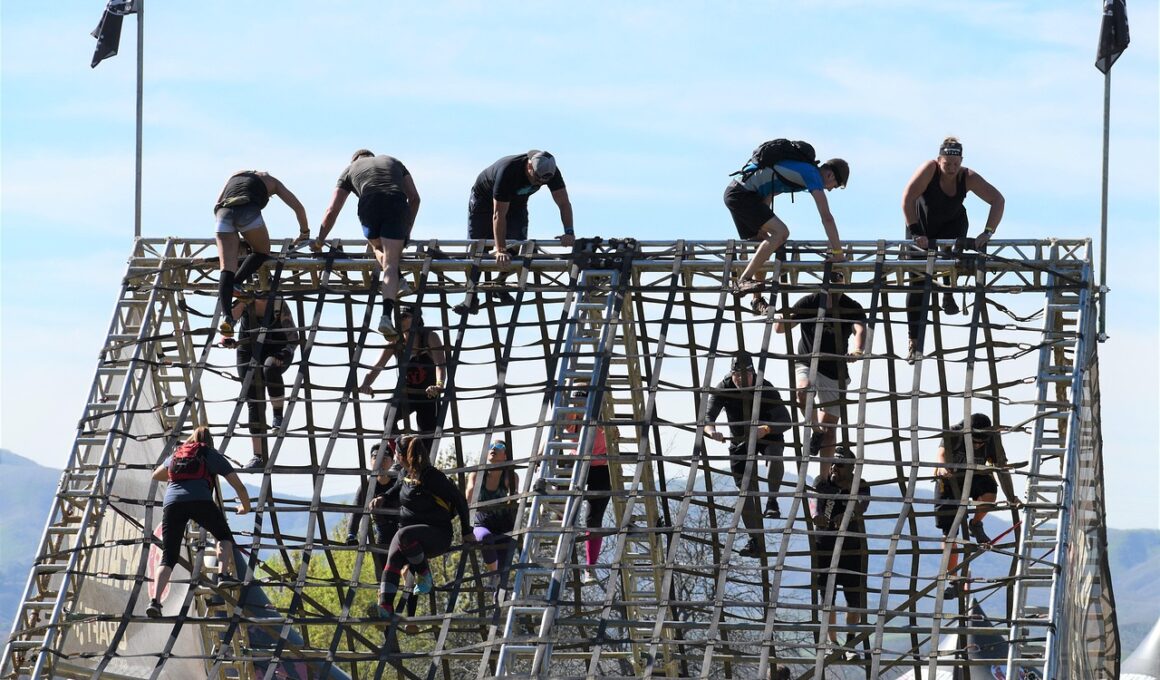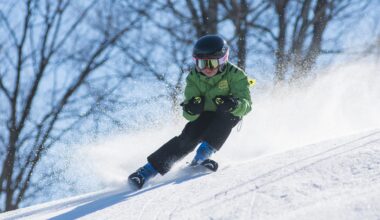Using Resistance Bands and Weights for Winter OCR Strength Training
Obstacle course racing athletes require a specific set of skills and strength to excel, particularly during the winter months, when outdoor training may not always be possible. Resistance bands and weights become valuable tools for maintaining and building strength during these colder periods. They facilitate various exercises that target muscles critical for running, climbing obstacles, and endurance. Training effectively with these tools is essential for enhancing overall performance when racing season arrives. Not only do they help build strength, but they also improve flexibility and agility, which are vital for navigating obstacles in races. Setting a consistent winter training schedule with these tools can help athletes stay in shape, avoiding the detriments of inactivity that often occur during colder months. Consistency is key, and with the right exercises, you can achieve effective winter training goals. Furthermore, incorporating resistance bands offers an adaptable workout that can easily be adjusted for different levels of intensity, and they are particularly easy to use for both beginners and advanced racers. With a commitment to integrating these tools into your training, you can ensure you’re ready for OCR events come spring.
The Importance of Strength in OCR
Strength plays a significant role in obstacle course racing and can be the deciding factor between success and failure during a race. During an OCR, contestants face a variety of unique challenges that test their physical and mental fortitude. This makes it essential for racers to build the necessary strength, particularly in their core, arms, and legs, in preparation for tackling these challenges effectively. Resistance bands provide a way to perform a variety of strength-building exercises targeting these specific muscles. Weights, on the other hand, promote overall body strength and stability, crucial for executing complex maneuvers throughout a course. For those inclined to work at home or in a gym, integrating weighted training and resistance band workouts can help improve both explosive strength and endurance. Multi-set training with weights develops muscle endurance, while resistance bands allow for controlled movements that help prevent injuries. By blending these techniques into your winter routine, you create a comprehensive approach to strength training that prepares you for any obstacle. Enhancing your overall strength and conditioning during winter gives you a competitive edge in the spring racing season.
When considering the use of resistance bands in winter OCR training, it is essential to focus on form and function. Utilizing the correct techniques when incorporating resistance bands can enhance performance while preventing injuries. Starting with exercises such as banded squats and chest presses can build stability and strength in your legs and core. As you become more comfortable with these movements, increase the resistance to match your growing strength levels. For a more advanced session, consider adding compound exercises such as squats combined with shoulder presses using the bands, as they engage multiple muscle groups simultaneously. Furthermore, working with a partner or coach can help ensure that you maintain the correct form, which is especially important for maximizing effectiveness and minimizing risk. Experiment with different resistance levels and a range of movements to keep your workouts engaging and prevent boredom. Integrating resistance bands into your regimen promotes versatility and adaptability, enabling athletes to prepare for unexpected challenges during races. This training method can be particularly effective during the harsh winter months when outdoor training is limited.
Incorporating weights into your winter training for OCR can be a game-changer for enhancing overall performance. Free weights, kettlebells, and weight machines are all effective tools in building strength and endurance. Start by establishing a balanced workout regimen that focuses on major muscle groups critical for OCR. Exercises like deadlifts, bench presses, and rows are fantastic for building upper body and core strength. It is recommended to perform these exercises in a progressive overload scheme, meaning gradually increasing the weights you lift can promote muscle growth and strength gains. Incorporating functional movements such as thrusters and farmer’s walks can enhance your muscular endurance, vital for completing obstacles efficiently. Weight training helps in developing better control of your movements, enabling you to navigate tough terrains and obstacles seamlessly. Additionally, it fosters mental toughness, which is crucial during steep climbs or challenging courses. Set specific and measurable goals for your weight training regimen to track progress. By committing to a weight training routine this winter, you will set yourself up for tremendous success when warm weather and race day finally arrive.
Combining resistance bands and weights can create a dynamic winter training program for OCR athletes. This approach allows for addressing every aspect of fitness, from strength building to endurance training. Begin each session with a warm-up that includes dynamic stretches, ensuring your muscles are prepared for the workout ahead. Transition into a series of circuit training routines alternating between resistance band exercises and weightlifting to effectively engage various muscle groups. For instance, perform a set of banded squats followed by a set of deadlifts, with minimal rest between. This format not only enhances muscular endurance but also improves cardiovascular conditioning, essential for racing. Another effective strategy is to incorporate high-intensity interval training (HIIT) with these tools to maximize calorie burn while building strength. Integrating core-focused exercises such as planks using bands can help improve stability and balance during races. Lastly, always prioritize recovery to prevent overtraining during winter months. Focus on proper nutrition, hydration, and adequate rest to recover and support your body through intense training. By maintaining a well-rounded training approach, you will find significant improvements in your OCR performance.
Creating a Training Schedule
Having a structured training schedule is crucial for effectively utilizing resistance bands and weights during winter. Start by setting aside adequate time each week to focus on your strength training, ensuring at least three to four sessions per week. Each session should include a blend of workouts targeting both resistance bands and weights, allotting equal time for each to maximize muscle engagement. Consider cycling through different muscle groups on different days; for instance, move from upper body workouts on one day to lower body workouts the next. This approach allows for recovery while promoting muscle growth. Don’t forget to incorporate rest days, allowing your body to recover and preventing injury from overexertion. Tracking your progress in terms of weights lifted or resistance band levels can help keep you motivated. Additionally, setting milestones, such as increased endurance in lifting or improved technique in band exercises, provides a rewarding way to stay focused. Having a routine in place prepares athletes for competitions and instills a sense of discipline and commitment necessary for success.
Lastly, staying mentally motivated during your winter OCR training is essential for achieving your goals. Engaging with a community or finding a training partner can provide support and accountability throughout your training process. Additionally, consider participating in online challenges or groups focused on OCR preparation to keep spirits high. Sharing progress, struggles, and victories with others can create a sense of belonging and encouragement that fuels dedication. Visualizing success, whether it’s completing a race or mastering a particular exercise, can enhance mental resilience and focus. Furthermore, setting short-term goals alongside long-term goals can provide small wins along the journey. Celebrate the little victories, such as hitting a new personal record with weights or completing a challenging resistance band workout. Use various forms of media, like motivational podcasts or documentaries focusing on OCR athletes, to maintain inspiration. Keeping a training journal can also be an excellent way to reflect on your journey and track improvements over time. By focusing on both mental and physical aspects, you can ensure a successful winter training program that enhances your strength for upcoming OCR events.
Conclusion
In conclusion, winter training using resistance bands and weights is crucial for OCR athletes looking to maintain their strength and performance throughout colder months. By strategically integrating both types of training into your regimen, you not only enhance muscle strength but also improve overall physical conditioning. Consistency and proper planning lead to significant advancements in your abilities come race season. Remember to focus on form, create a balanced training schedule, and prioritize mental motivation to achieve your fitness goals. Adjusting your routine as necessary based on personal progress will also contribute positively to your training experience. Explore various exercises with each training tool, ensuring a versatile approach to your workouts. Through commitment and energy, you can prepare yourself to face any challenges that lie ahead in your racing career. Embrace the winter months as an opportunity to build resilience, both physically and mentally. As the competition season approaches, effective winter training can set you apart from your competitors, propelling you towards racing success. The time spent preparing during winter will undoubtedly pay off, allowing you to approach the start line with confidence and strength.


